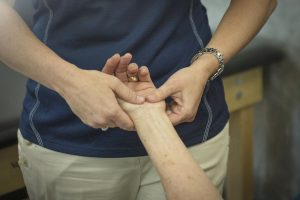
A Pain in the Wrist: Common Diagnoses
6 CommentsPinching. Gripping. Pushing. Lifting. We do all of these functions with our hands daily without thinking about it. But what if one of these basic functions causes pain in the wrist? It becomes noticeable and affects our daily life.
Due to the anatomical complexity of the wrist, the causes of wrist pain are numerous. Below are several common diagnoses associated with generalized wrist pain along with basic treatment options.
Flexor or Extensor Tendonitis: Tendons that move the wrist, digits and thumb cross the wrist at both the palmar and back (dorsal) side of the wrist. Inflammation in these tendons can occur at the wrist level, causing tendonitis and subsequent pain. This pain can be localized at any point, from thumb to pinky, and visible swelling may be present. Although pain can occur at rest, it is more likely to occur with resistance to that muscle and tendon, including gripping, pushing off of wrist and activities that require extreme end-ranges of wrist motion.2
DeQuervain’s Tenosynovitis: All tendons that cross through the back of the wrist pass through a pulley system known as the tendon sheath. In addition to the tendon itself becoming inflamed, the sheath can become inflamed or thickened, causing wrist pain on the thumb side. Two of the tendons responsible for thumb motion pass through one sheath together and are especially susceptible to irritation; this is known as deQuervain’s tenosynovitis. In addition to pain with gripping, there may be catching or snapping heard or felt and an increase in discomfort when the wrist is moved toward the pinky while bending the thumb. Like general flexor or extensor tendonitis, swelling may be present at the dorsal/thumb side. This condition occurs more in females than males.1
Carpal Tunnel Syndrome: The term carpal tunnel syndrome (CTS) is familiar to most people but is sometimes poorly understood. The condition refers to compression of the median nerve, which travels through the palmar wrist, and is characterized by tingling and/or numbness in the index, middle and a portion of the ring finger – although there are anatomical variations. These symptoms may be more noticeable at night time. In addition to the tingling/numbness, weakness may be present especially with gripping and thumb opposition (moving toward base of small finger) as well as pain at the palmar side of the wrist. Although CTS is compression of a nerve, the problem may originate from inflammation of the tendons on the palmar side of the wrist that flex the digits, thumb and wrist pressing the median nerve against the transverse carpal ligament. CTS also occurs more often in females than males.3
The previous three diagnoses are considered overuse or repetitive strain injuries, affecting tendons and their supporting soft tissue. The last diagnosis featured on this list is osteoarthritis, a joint-related concern that is most often related to aging.
CMC Arthritis: Although this is anatomically the base of the thumb, it can be mistaken for wrist pain. The trapezium of the wrist and metacarpal of the thumb form a saddle joint, unique to this joint alone, that allow the wide range of movement and function of the thumb. Unfortunately, it is also very susceptible to osteoarthritis. Pain occurs at the base of the thumb especially with pinching activities, such as turning a key, writing, and fine motor activities like buttoning. This pain is the result of an increase of “bone on bone” friction, which is the hallmark x-ray sign of osteoarthritis.
Treatment Options
 Acute wrist pain is best treated with rest and ice. All of these diagnoses may also benefit from immobilization with an orthosis (splint), like a simple wrist immobilizer for flexor and extensor tendonitis and CTS, as well as a wrist immobilizer including thumb (thumb spica) for DeQuervain’s tenosynovitis and CMC arthritis. Both of these orthoses are available over the counter at a pharmacy. Nonsteroidal anti-inflammatory drugs (NSAIDs) such as ibuprofen (Advil) or naproxen (Aleve) can also reduce inflammation and help compliment the rest and ice regimen. That said, it is always best to speak with a physician before taking medicine.
Acute wrist pain is best treated with rest and ice. All of these diagnoses may also benefit from immobilization with an orthosis (splint), like a simple wrist immobilizer for flexor and extensor tendonitis and CTS, as well as a wrist immobilizer including thumb (thumb spica) for DeQuervain’s tenosynovitis and CMC arthritis. Both of these orthoses are available over the counter at a pharmacy. Nonsteroidal anti-inflammatory drugs (NSAIDs) such as ibuprofen (Advil) or naproxen (Aleve) can also reduce inflammation and help compliment the rest and ice regimen. That said, it is always best to speak with a physician before taking medicine.
It is also important to note that all of these diagnoses can benefit from an improvement in posture and body mechanics, decreasing overuse and strain on tendons or joints. Avoiding extremes of wrist and thumb motion decreases stress on these structures and is feasible in most activities of daily living. Examples include keeping wrist in a neutral position when typing, using electronic devices, styling hair or driving. For CMC arthritis, decreasing force required when pinching can help decrease pain; this can be achieved with increased circumference of tools (including pens, cooking utensils, work tools) or by using electronic can and jar openers. Chronic arthritis may respond better to heat than ice after acute flare-up.
Keep in mind that stretching and massage are also beneficial, as doing so increases blood flow to affected areas. Try the Wrist ROM stretch for some relief with any of these diagnoses, or the Self-Massage for the Wrist technique for CMC arthritis.
Lastly, it is important not to ignore or “work through” pain. What may start as a problem that is simple to treat can quickly turn to a chronic problem requiring more intervention. If you have pain in your wrist, please contact your nearest Athletico clinic for a free assessment.
The Athletico blog is an educational resource written by Athletico employees. Athletico bloggers are licensed professionals who abide by the code of ethics outlined by their respective professional associations. The content published in blog posts represents the opinion of the individual author based on their expertise and experience. The content provided in this blog is for informational purposes only, does not constitute medical advice and should not be relied on for making personal health decisions.
References:
1. “De Quervain’s Tendinosis-OrthoInfo – AAOS.”Ortho Info. AAOS, n.d. Web. 7 Sept. 2016. <http://orthoinfo.aaos.org/topic.cfm?topic=A00007>.
2. “Wrist Tendonitis.”Wrist Tendonitis. Sports Injury Clinic, n.d. Web. 7 Sept. 2016. <http://www.sportsinjuryclinic.net/sport-injuries/wrist-pain/wrist-tendonitis>.
3. “Carpal Tunnel Syndrome Information Page: National Institute of Neurological Disorders and Stroke (NINDS).”S National Library of Medicine. NIH, n.d. Web. 7 Sept. 2016. <http://www.ninds.nih.gov/disorders/Carpal_tunnel/Carpal_tunnel.htm>.


6 Comments
Michael
You don’t mention cubital tunnel syndrome. What is the relationship to carpal tunnel syndrome? What is the relationship to weather conditions with the two?
tony jania
A grateful thank you for this particular informative tutorial and links. Really appreciated.
Rose McAndrew
Please see another one of my blogs titled “Cubital Tunnel: The other tunnel.” This might answer some of your questions.
http://www.athletico.com/2015/10/22/cubital-tunnel-the-other-tunnel/
Loli Wang
Thank you for sharing so useful info. Like other orthopaedic conditions, carpal tunnel syndrome becomes worse if you don`t treat it, complications will occur. Unfortunately, there is no simple way of finding out this health condition. An expert orthopaedic will reveal it with physical examination and X rays.
Jane Ko
It’s two years have passed, and my wrist pain continuously occurs.
Athletico
Hi Jane – Thanks for reaching out. If you have questions about your pain or injury, please schedule a free assessment with one of our clinicians – http://www.athletico.com/FreeAssessment